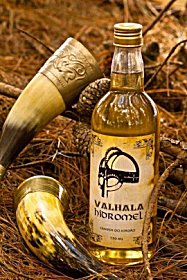MessageToEagle.com – Medieval Norse-Icelandic sagas are filled with tales of mead-drinking Norse Gods and beautiful Valkyries serving refreshments to fallen warriors in Valhalla.
Similarly, the archeological record of Scandinavia is full of drinking vessels, brewing equipment and images of happy drinkers.
The god Odin was said to have gained his strength because he drank mead as a suckling baby.
Mead, as a drink for the gods, is mentioned in Greek myths.
Vikings are said to have gained strength by drinking mead.
Viking settlements often elaborate feasts and enjoyed them very much. They also enjoyed alcoholic beverages such as ale, a strong drink brewed from roasted barley. Feasts were often held in celebration of seasonal festivals related to midwinter, harvest and often during funerals.
More famously, mead was the beverage of choice, a drink made by fermenting honey with water, and sometimes with grains, hops or, if they were available spices and berries.
Beverages were enjoyed most commonly from wooden cups.

See also:
Runes: Facts And History About Odin’s Secret Language
10 Great Viking Misconceptions Still Being Perpetuated
Heimdallr: Norse God Who ‘Illuminates The World’ And Guards The Rainbow Bridge Bifröst In Asgard
Was mead a medicine drink?
What was this superpower-giving drink that was famous all over the ancient world? We know that the mead contained honey.
According to a study medicinal importance of honey has been documented in the world’s oldest medical literatures, and since the ancient times, it has been known to possess antimicrobial property as well as wound-healing activity.
The healing property of honey is due to the fact that it offers antibacterial activity, maintains a moist wound condition, and its high viscosity helps to provide a protective barrier to prevent infection.
It remains unknown how humans discovered the sweet and healing properties of honey
The earliest archaeological evidence for mead-making dates back to the 7th century BC in China. But some experts think people have been getting inebriated off honey for far longer. “I personally believe humans have known how to ferment honeys since they left Africa,” said mead and honey winemaker Ken Schramm.
Scientists think our ancestors discovered mead accidentally, when tasting naturally fermented honey in beehives, or by adding honey to rotten fruit as a preservative.
The mead that the Vikings drank became the main focus of a research study led by microbiologist Tobias Olofsson from Lund University in Sweden. He says that this ancient elixir, combined with modern science, can be the answer in a world full of antibiotic-resistant superbugs.
In a 2014 study he published in the International Wound Journal, Olofsson found that the most medicinal part of honey, “lactic acid bacteria,” or LAB multiplied from 100 million per gram of honey into 100 billion per gram of mead in the fermenting process.
Honey hunters were going out and getting honey from trees that was still at 25 to 30 percent water content,” Olofsson said.
“What they were getting is a living medicine.” Olofsson also suspects that ancient honey hunters unwittingly made medicinal mead from immature honeycombs. “To get all of the honey out of the wax combs, honey makers would stick them in water,” Olofsson said. “After a day or two of standing, you had an alcoholic beverage.”
MessageToEagle.com
References:
US National Library of Medicine
Tech Times
Gizmodo
Bivrost








